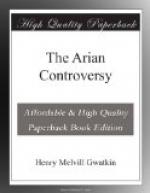The Eusebians began by offering a meagre and evasive creed, much like the confession of Arius and Euzoius, prefacing it with a declaration that they were not followers of Arius, but his independent adherents. They overshot their mark, for the conservatives were not willing to go so far as this, and, moreover, had older standards of their own. Instead, therefore, of drawing up a new creed, they put forward a work of the venerated martyr Lucian of Antioch. Such it was said to be, and such in the main it probably was, though the anathemas must have been added now. This Lucianic formula then is essentially conservative, but leans much more to the Nicene than to the Arian side. Its central clause declares the Son of God ’not subject to moral change or alteration, but the unvarying image of the deity and essence and power and counsel and glory of the Father,’ while its anathemas condemn ’those who say that there was once a time when the Son of God was not, or that he is a creature as one of the creatures.’ These are strong words, but they do not in the least shut out Arianism. No doubt the phrase ’unvarying image of the essence’ means that there is no change of essence in passing from the Father to the Son, and is therefore logically equivalent to ’of one essence’ (homoousion); but the conservatives meant nothing more than ‘of like essence’ (homoiousion), which is consistent with great unlikeness in attributes. The anathemas also are the Nicene with insertions which might have been made for the very purpose of letting the Arians escape. However, the conservatives were well satisfied with the Lucianic creed, and frequently refer to it with a veneration akin to that of Athanasius for the Nicene. But the wire-pullers were determined to upset it. The confession next presented by Theophronius of Tyana was more to their mind, for it contained a direct anathema against “Marcellus and those who communicated with him.” It secured a momentary approval, but the meeting broke up without adopting it. The Lucianic formula remained the creed of the council.
[Sidenote: The fourth creed.]
Defeated in a free council, the wire-pullers a few months later assembled a cabal of their own, and drew up a fourth creed, which a deputation of notorious Arianizers presented to Constans in Gaul as the genuine work of the council. It seems to have suited them better than the Lucianic, for they repeated it with increasing series of anathemas at Philippopolis in 343, at Antioch the next year, and at Sirmium in 351. We can see why it suited them. While in substance it is less opposed to Arianism than the Lucianic, its wording follows the Nicene, even to the adoption of the anathemas in a weakened form. Upon the whole, it is a colourless document, which left all questions open.
[Sidenote: Constans demands a council.]




